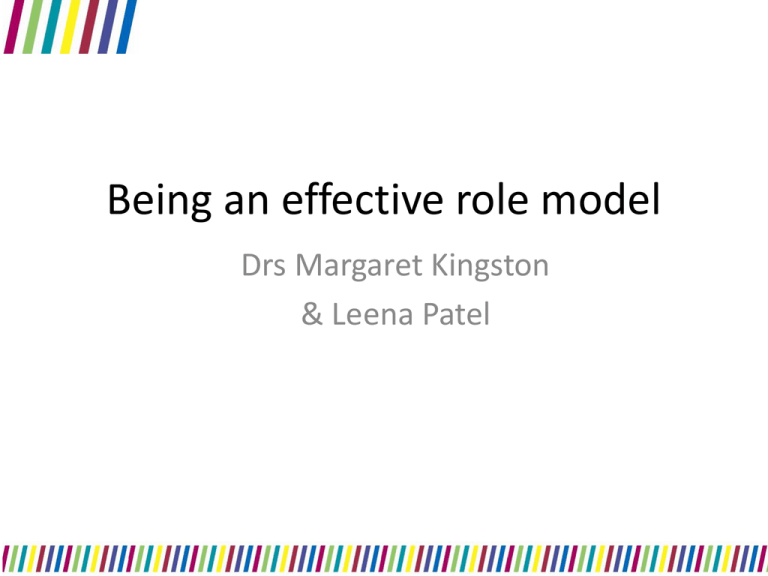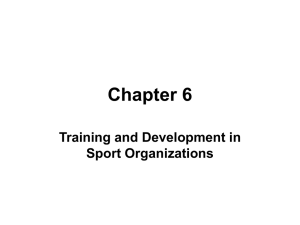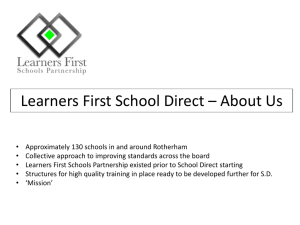Being an effective role model
advertisement

Being an effective role model Drs Margaret Kingston & Leena Patel You ARE a role model, but are you always a good one? Being a positive role model is: A key attribute of a successful doctor A requirement of all UK registered doctors by the General Medical Council Education is an integral part of medical practice & learning form role models is an important aspect of medical education because: It teaches the application of knowledge and skills Influences career choices Is how our students and trainees develop professionalism Students & trainees are aware of their role models - good & bad! “I think a role model is the single best way to learn… if you can see someone do it and understand how and why they do it, I think that’s when you’ll get it” “Enthusiastic about her discipline, involved students actively in the work, excellent knowledge and practical skills, nice to patients, staff and students” “I’ve found my first rotation was very stressful, humiliating, I worked and read because of fear…” Personal considerations… Who are / were your role models? What was their influence on your learning and career choices? Who are you a role model for? What are your good and bad attributes as a role model? ILOs for this workshop “Research indicates that being a positive role model is a set of skills, attitudes and behaviours which may be taught and acquired by doctors…” Define positive and negative attributes of a role model Understand how learning from role models happens How you can effectively teach through role modelling Studies have established the attributes reported in medical role models: Individuals who: Excel in their clinical knowledge and skills Through communication skills they maintain good professional relationships Are effective and enthusiastic teachers A tall order! Students & trainees have multiple role models, learning different things from different individuals; the “composite” role model How learning from role models happens This is a complex process! Aspects have been explained through various learning theories: Individuals learn “to talk, from talk” Students & trainees learn professionalism through the “Hidden Curriculum” : This is a process of assimilation into a community of practice, not only by possession of shared expertise, but also the development of professional values and standards Cruess, 2008 Video clip (cardiac arrest, first episode, see youtube!) • For those you consider to be acting as a role model in these scenarios: – What positive attributes of a role model are they displaying? – Are they demonstrating any negative role model attributes? – How could learning through role modelling be improved in this situation? Positive role model attributes • • • • • • • • • • • • • • Personal characteristics Compassion Caring Empathic Patient-centred approach Excellent communication skills Good inter-professional relationships Respectful Good team player Demonstrates leadership Integrity Honesty Good sense of humour Calm Positive attitude Clinical skill • Practically skilful • Demonstrates clinical competence • Knowledgeable • Sound clinical reasoning • Ability to reach the correct diagnosis • Strives for excellence • Presentation skills • Aware of own strengths and weaknesses Positive role model attributes Teaching abilities • • • • • • • • • • Taking an interest in students and trainees Spending time with students and trainees Enthusiasm Patience Provide clear explanations Versatile, learner centred teaching style Constructive feedback Demonstrating clinical reasoning Facilitation patient interaction and learning opportunities Identifying opportunities for reflection Negative role model attributes Personal characteristics • Making derogatory comments about patients or fellow professionals • Inappropriate humour directed at patients or colleagues • Lack of empathy • Unfriendliness • Complaining • Expressing anger or frustration • Bitterness and cynicism • Opinionated • Lack of confidence • Un co-operative Clinical skill • Lack of knowledge Teaching abilities • Forgetting names and faces • Excessive criticism • Frightening or humiliating students or trainees • Promoting unnecessary competition between students or trainees How to MAXIMISE learning through role modelling 1. Attention: Drawn attention to the behaviour or skill being modelled by: I. II. III. IV. 2. 3. 4. Physically emphasising it Asking them relevant questions Providing an enthusiastic narrative Subdividing and explaining specific aspects of a complex skill. Retention: This may be enhanced by adoption of the following strategies: I. Repetition of a skill or relaying of an important fact II. Symbolic representation to create visual memory III. Drawing appropriate parallels or realistic exemplification of possible harmful effects (e.g. giving telling examples) IV. Relating new to existing knowledge Production: Provide experience with appropriate autonomy Motivation: I. II. Awareness of motivators for learners including personal rewards such as enjoyment, enthusiasm and dedication, financial gains or social status, professional autonomy or influence. Increasing frequency and magnitude of observed rewards & concurrence with the trainee’s own aspirations increases the effect. How to MAXIMISE learning through role modelling Wright & Caresse, 2002 How to MAXIMISE learning through role modelling Blue sky thinking…. When it gets tough…. 1. 1. 2. 3. 4. 5. 6. 7. 8. Remember – you are a role model! Make time for teaching Explicitly model skills & behaviours Recognise & use seminal events Provide experience & feedback Creating a positive learning environment and culture Providing learner centred teaching Show you love it! Time for teaching: – “Teaching when time is limited – Irby BMJ 2008; 336: 384 ” 2. Competing priorities: – Demonstrate how these are managed, including work-life balance/merge 3. Adverse work related pressures: – Explicitly model effectively dealing with these Time to have a quick go? Feedback from role pay 1. The scenario 2. Positive role modelling skills to be utilised 3. Barriers to learning Scenario one Positive role modelling Barriers to learning from skills to be utilised effective role modelling Patient centred Personal opinions Problem Based Learning approach Attitudes of other (PBL) group and during a Excellent case discussion one communication skills Inappropriate humour You are the tutor of a students member of the group Respectful Excessive criticism expresses homophobic Positive attitude Humiliating or and racist attitudes; how Constructive feedback do you handle this? Versatile learner Patience centred teaching Clear explanation frightening approach Scenario two Positive role modelling Barriers to learning from skills to be utilised You are in a busy clinic and a effective role modelling Compassion Lack of empathy Time pressure patient who has recently Caring received a serious diagnosis Patient centred is very distressed. You have a approach student sitting in. How do you Excellent handle the patient and communication effectively teach the student? skills Calm Hot review Identifying opportunities for reflection Scenario three Positive role modelling Barriers to learning from skills to be utilised effective role modelling Patient centred Lack of confidence procedure with a student approach Time pressure in attendance, how do you Practically skilful You are undertaking a effectively teach the student to do this? Facilitating patient interaction and opportunity for learning Patience Explicitly demonstrating skills So, in summary, being a good role model is important! Because, being a positive role model is A key attribute of a successful doctor A requirement of all UK registered doctors by the General Medical Council Furthermore, our students and trainees learn important skills and make important choices because of this: Through it they learn the application of knowledge and skills We influence their career choices It is how our students and trainees develop professionalism – which has never been more important than it is now! You ARE a role model; how can you be a good one (nearly) all the time? 1. Remember that you are a role model 2. Actively demonstrate your positive role model characteristics and skills 3. Actively demonstrate dealing with challenges 4. Create opportunities for authentic learner centred experiences with constructive feedback 5. Enjoy yourself! ILOs for this workshop Define positive and negative attributes of a role model Understand how learning from role models happens How you can effectively teach through role modelling Thank you for your participation Any last questions or comments?






